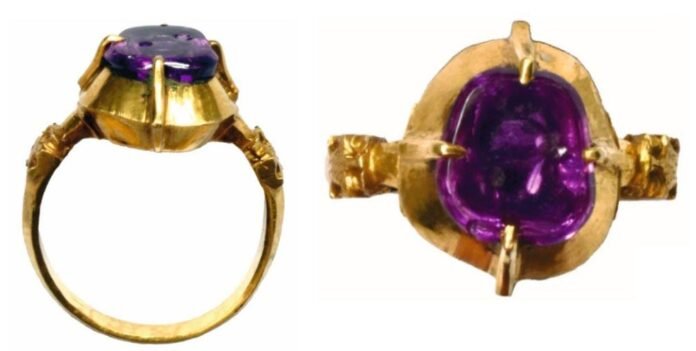A medieval golden ring with a reddish-purple sapphire from Sri Lanka.
A medieval ring featuring a rare sapphire indicates a long-distance gemstone trade between Europe and Sri Lanka over 700 years ago.
The ring was discovered at what is now Pustý hrad (meaning “deserted castle”) above Zvolen, Slovakia, in 2001 during an illegal treasure hunt in the ruins of the former fortress. It was handed over to authorities 22 years later.
The 18-karat golden ring, dating from around 1300 based on similar designs, holds a reddish-purple sapphire with an estimated weight of about 2.00 carats. This high-quality gemstone was highly valued at the time, as Europe lacked significant sapphire deposits. Wearing such jewelry would have symbolized great wealth and high social status.
Noémi Beljak Pažinová, a professor at the University of Nitra’s Department of Archaeology, along with a team of archaeologists and mineralogists, analyzed the gemstone’s chemical composition and crystal properties to determine its possible origin.
Sapphire, a variety of the mineral corundum, is mostly composed of aluminum oxide. While pure corundum is colorless, trace elements like iron, titanium, chromium, gallium, and vanadium impart various colors including blue, yellow, red, green, pink, or purple. The most prized color varieties are blue (iron-titanium sapphire), red (chromium ruby), and pink (chromium rose sapphire).
A miner holding a single sapphire from Sri Lanka. They are typically found as loose crystals in … More
Play Puzzles & Games
By analyzing the trace elements within the sapphire and comparing them to sapphires from around the world, the research team concluded that the gemstone most likely originated in Sri Lanka. It is believed the sapphire traveled by sea and land, shipped from Sri Lanka to India, passing through the Middle East before reaching European merchants in Aleppo, present-day northern Syria, or Constantinople, now Istanbul, Turkey. This lengthy journey, combined with the rarity and beauty of sapphires, likely contributed to its high value.
Pustý hrad Castle was constructed in the late 12th century and functioned as the administrative center of Zvolen County before evolving into a significant Hungarian royal fortress. It is possible that the ring was worn by a royal or high-ranking individual, potentially serving as a bishop’s ring of office. An engraving on the sapphire depicts a stylized lion, symbolizing strength, courage, and royalty, as well as being associated with Mark the Evangelist.
The study, “Archaeometric study of a unique medieval golden ring with a reddish-purple sapphire (corundum) gemstone from the Zvolen Castle, Slovakia,” was published in the Journal of Archaeological Science: Reports.






